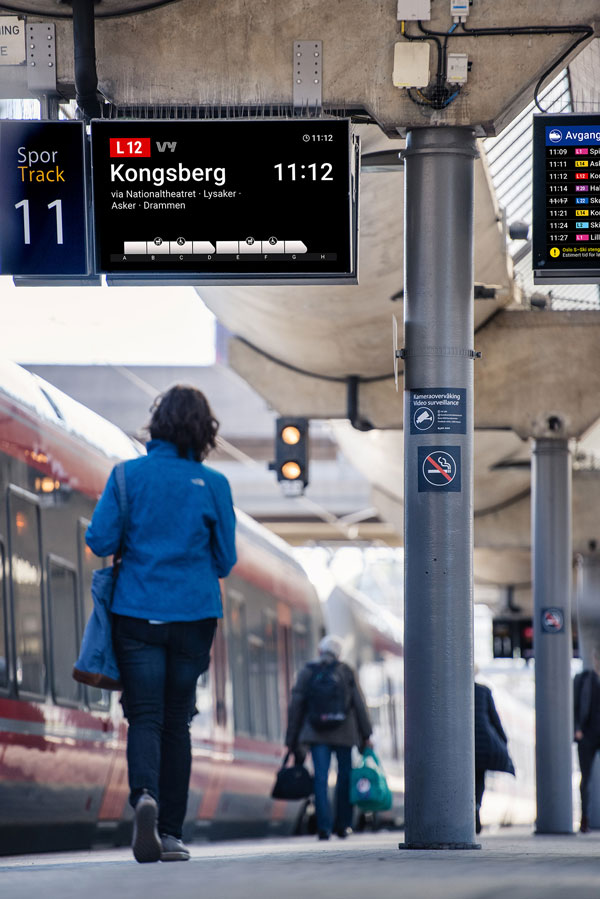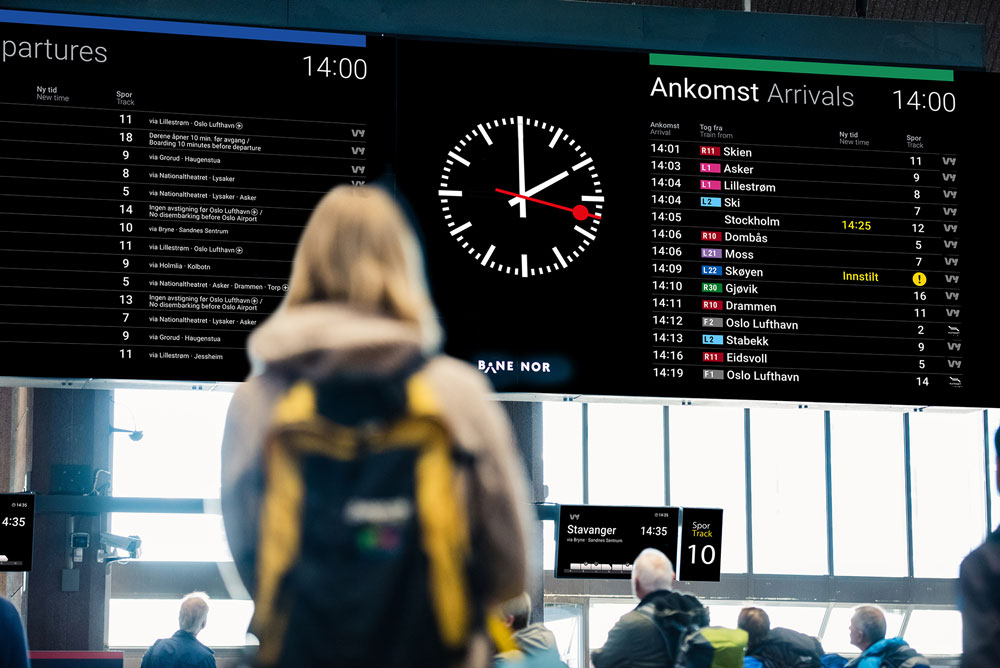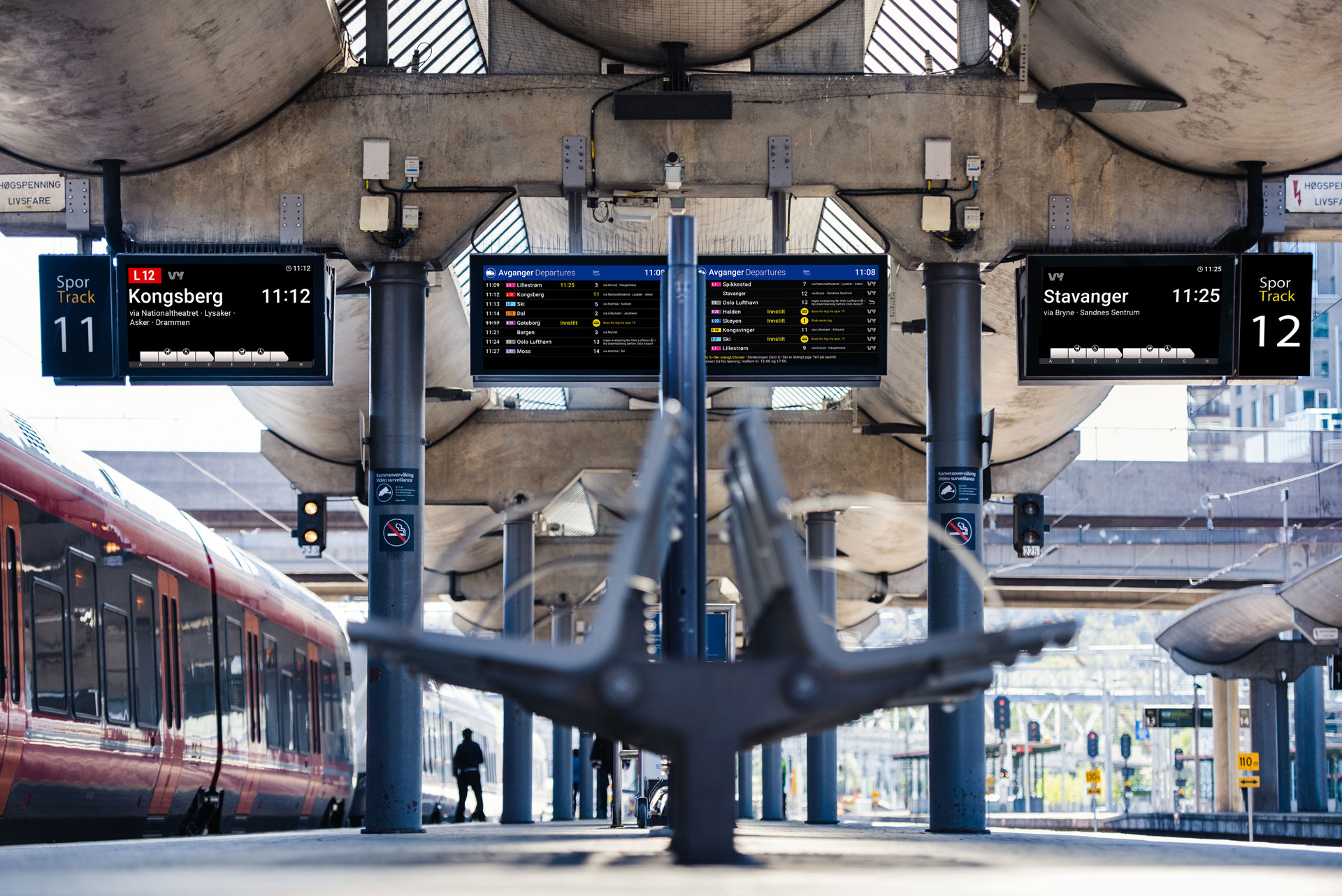Funkwerk Mobility Platform: our References
Bane NOR –
Norway
Proven in practice: On this page you will find use cases and references relating to the use of the Funkwerk Mobilty Platform.
The name KARI is synonymous with the new age of passenger information in Norway: The system from Funkwerk ensures that passengers nationwide are provided with visual and acoustic real-time information on rail services.
More than 300 stations are integrated into the passenger information system: It controls more than 300 announcement devices and 1,300 displays simultaneously. The Norwegian national railway administration, Bane NOR, stated in its objective that, on the one hand, it wanted to increase passenger satisfaction, but on the other hand, it also wanted to achieve fully automatic control of the information output while at the same time reducing manual processes.
Thus, in close coordination with the customer Bane NOR, a system was developed that is characterised by its modular architecture. All functions are subdivided into independent software subsystems that are mapped centrally via a user-friendly interface. In the daily work processes, this significantly reduces the effort required to control so-called business transactions (delays, service interruptions, etc.).

Nationwide real-time information system
Bane NOR uses a reliable and expandable nationwide real-time information system for passenger information. This automatically controls the visual and acoustic information output at over 340 stations. In addition to information on regular services, this also supports information on delays, service deviations and interruptions. Both data on planned and current operations, i.e. target and actual timetables, are continuously processed to provide up-to-date real-time information. To ensure that the system remains fail-safe, the system server is configured in redundant stand-by mode.
Modular software architecture
Thanks to the modular software architecture, individual functions are distributed in independent subsystems developed by Funkwerk. Each of these subsystems has its own tasks and interfaces to the others and calculates the information output with the input data and defined configuration parameters.
From the Bane NOR timetable tool with the railML data structure, long and short term timetables including deviations are imported and processed. Based on the interlocking system and GPS tracker, train positions and forecasts and current arrival and departure times (taking into account catch-up times) are calculated in real time via the KAFKA adapter. Three different interlocking variants are integrated. So-called advisories, such as the indication of an alternatively arranged rail replacement service, are also received as real-time data. Wagon levels and utilisation are recorded by means of sensors.
Some real-time data is derived for statistical analysis so that signals can be suggested for configuration and off-set values calculated to optimise the following year’s period timetable.

Information display can be varied in the layout
The passenger information displays run with HTML5/ WebSocket technology and are variable in layout. They show the current carriage line-up, service attributes and the vehicle occupancy level as well as the stop position on the platform automatically adjusted to the vehicle length and direction of travel. Self-generated information texts can be displayed simultaneously or alternately in two languages.
Acoustic information via text-to-speech
Modern text-to-speech technology is used for the output of acoustic information. It is triggered type-specifically either via triggers or temporal parameters in real time. An announcement can be made in Norwegian and English and at a volume adapted to the operating environment.
Implementation of the open standard SIRI
Bane NOR’s passenger information system is by no means an isolated system: in order to provide other railway companies and their services with real-time data, the open standard SIRI (Service Interface for Real Time Information) has been implemented in KARI. This means that third-party providers receive timetables, real-time data and forecasts.
Components of the
Mobility Platform
Passenger information
Passenger information systems enable the fully automatic control of all processes in the operational sequence.
Displays
Indicators, displays, columns and monitors provide passengers with visual information in real time.
Public address
Public address systems ensure that important information and announcements are also given out acoustically.
Text-to-Speech
Text-to-speech is the digital generation of speech from text. Announcements can be synthesised live.
Funkwerk Mobility Platform: our references
Bane Nor –
Norway
Proven in practice: On this page you will find use cases and references relating to the use of the Funkwerk Mobilty Platform.
The name KARI is synonymous with the new age of passenger information in Norway: The system from Funkwerk ensures that passengers nationwide are provided with visual and acoustic real-time information on rail services.
More than 300 stations are integrated into the passenger information system: It controls more than 300 announcement devices and 1,300 displays simultaneously. The Norwegian national railway administration, Bane NOR, stated in its objective that, on the one hand, it wanted to increase passenger satisfaction, but on the other hand, it also wanted to achieve fully automatic control of the information output while at the same time reducing manual processes.
Thus, in close coordination with the customer Bane NOR, a system was developed that is characterised by its modular architecture. All functions are subdivided into independent software subsystems that are mapped centrally via a user-friendly interface. In the daily work processes, this significantly reduces the effort required to control so-called business transactions (delays, service interruptions, etc.).

Nationwide real-time information system
Bane NOR uses a reliable and expandable nationwide real-time information system for passenger information. This automatically controls the visual and acoustic information output at over 340 stations. In addition to information on regular services, this also supports information on delays, service deviations and interruptions. Both data on planned and current operations, i.e. target and actual timetables, are continuously processed to provide up-to-date real-time information. To ensure that the system remains fail-safe, the system server is configured in redundant stand-by mode.
Modular software architecture
Thanks to the modular software architecture, individual functions are distributed in independent subsystems developed by Funkwerk. Each of these subsystems has its own tasks and interfaces to the others and calculates the information output with the input data and defined configuration parameters.
From the Bane NOR timetable tool with the railML data structure, long and short term timetables including deviations are imported and processed. Based on the interlocking system and GPS tracker, train positions and forecasts and current arrival and departure times (taking into account catch-up times) are calculated in real time via the KAFKA adapter. Three different interlocking variants are integrated. So-called advisories, such as the indication of an alternatively arranged rail replacement service, are also received as real-time data. Wagon levels and utilisation are recorded by means of sensors.
Some real-time data is derived for statistical analysis so that signals can be suggested for configuration and off-set values calculated to optimise the following year’s period timetable.

Information display can be varied in the layout
The passenger information displays run with HTML5/ WebSocket technology and are variable in layout. They show the current carriage line-up, service attributes and the vehicle occupancy level as well as the stop position on the platform automatically adjusted to the vehicle length and direction of travel. Self-generated information texts can be displayed simultaneously or alternately in two languages.
Acoustic information via text-to-speech
Modern text-to-speech technology is used for the output of acoustic information. It is triggered type-specifically either via triggers or temporal parameters in real time. An announcement can be made in Norwegian and English and at a volume adapted to the operating environment.
Implementation of the open standard SIRI
Bane NOR’s passenger information system is by no means an isolated system: in order to provide other railway companies and their services with real-time data, the open standard SIRI (Service Interface for Real Time Information) has been implemented in KARI. This means that third-party providers receive timetables, real-time data and forecasts.
Components of the
Mobility Platform
Passenger information
Passenger information systems enable the fully automatic control of all processes in the operational sequence.
Displays
Indicators, displays, columns and monitors provide passengers with visual information in real time.
Public address
Public address systems ensure that important information and announcements are also given out acoustically.
Text-to-Speech
Text-to-speech is the digital generation of speech from text. Announcements can be synthesised live.

References
Bane NOR – Norway
The name KARI is synonymous with the new age of passenger information in Norway: The system from Funkwerk ensures that passengers nationwide are provided with visual and acoustic real-time information on rail services.
More than 300 stations are integrated into the passenger information system: It controls more than 300 announcement devices and 1,300 displays simultaneously. The Norwegian national railway administration, Bane NOR, stated in its objective that, on the one hand, it wanted to increase passenger satisfaction, but on the other hand, it also wanted to achieve fully automatic control of the information output while at the same time reducing manual processes.
Thus, in close coordination with the customer Bane NOR, a system was developed that is characterised by its modular architecture. All functions are subdivided into independent software subsystems that are mapped centrally via a user-friendly interface. In the daily work processes, this significantly reduces the effort required to control so-called business transactions (delays, service interruptions, etc.).

Nationwide real-time information system
Bane NOR uses a reliable and expandable nationwide real-time information system for passenger information. This automatically controls the visual and acoustic information output at over 340 stations. In addition to information on regular services, this also supports information on delays, service deviations and interruptions. Both data on planned and current operations, i.e. target and actual timetables, are continuously processed to provide up-to-date real-time information. To ensure that the system remains fail-safe, the system server is configured in redundant stand-by mode.
Modular software architecture
Thanks to the modular software architecture, individual functions are distributed in independent subsystems developed by Funkwerk. Each of these subsystems has its own tasks and interfaces to the others and calculates the information output with the input data and defined configuration parameters.
From the Bane NOR timetable tool with the railML data structure, long and short term timetables including deviations are imported and processed. Based on the interlocking system and GPS tracker, train positions and forecasts and current arrival and departure times (taking into account catch-up times) are calculated in real time via the KAFKA adapter. Three different interlocking variants are integrated. So-called advisories, such as the indication of an alternatively arranged rail replacement service, are also received as real-time data. Wagon levels and utilisation are recorded by means of sensors.
Some real-time data is derived for statistical analysis so that signals can be suggested for configuration and off-set values calculated to optimise the following year’s period timetable.

Information display can be varied in the layout
The passenger information displays run with HTML5/ WebSocket technology and are variable in layout. They show the current carriage line-up, service attributes and the vehicle occupancy level as well as the stop position on the platform automatically adjusted to the vehicle length and direction of travel. Self-generated information texts can be displayed simultaneously or alternately in two languages.
Acoustic information via text-to-speech
Modern text-to-speech technology is used for the output of acoustic information. It is triggered type-specifically either via triggers or temporal parameters in real time. An announcement can be made in Norwegian and English and at a volume adapted to the operating environment.
Implementation of the open standard SIRI
Bane NOR’s passenger information system is by no means an isolated system: in order to provide other railway companies and their services with real-time data, the open standard SIRI (Service Interface for Real Time Information) has been implemented in KARI. This means that third-party providers receive timetables, real-time data and forecasts.
Components of the
Mobility Platform
Passenger information
Passenger information systems enable the fully automatic control of all processes in the operational sequence.
Displays
Indicators, displays, columns and monitors provide passengers with visual information in real time.
Public address
Public address systems ensure that important information and announcements are also given out acoustically.
Text-to-Speech
Text-to-speech is the digital generation of speech from text. Announcements can be synthesised live.
